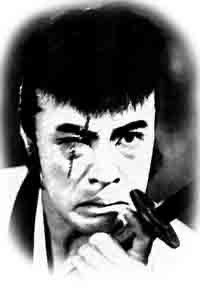The Asahi reports this morning that the illustrious art director, Kimura Takeo, passed away on March 21, 2010, of pneumonia. He was 91.
Kimura is most famous for his collaborations with Suzuki Seijun, but KImura had already worked in the industry for over 20 years before he first joined Seijun on Akutaro in 1963. Kimura entered the Nikkatsu Tamagawa studio in 1941, but debuted as an art director at Daiei (which took over Nikkatsu's production division during the big wartime mergers) in 1945. His first well-known works were literary adaptations such as Gan (1953) or family dramas such as Keisatsu nikki (Police Diary, 1955). He returned to Nikkatsu when it resumed production in 1954. He was central in helping create the "mukokuseki" or "nationless" feel of Nikkatsu Action films, creating a unique world mixing the imaginary and the real, foregrounding style and color. That in some ways culminated in his work on Seijun's Tokyo Drifter
(1966).
That was not his only style, however, as he also worked on the social realist films of Kumai Kei such as Shinobugawa (1972) and Umi to dokuyaku (Sea and Poison, 1986). His most famous work was probably Seijun's Zigeunerweisen (1980), but other well known films include Itami Juzo's Tampopo
(1985). He won a prize at the 1990 Montreal Film Festival for his work on Shikibu monogatari. As a footnote, Kimura was one of the eight people (including Sone Chusei, Yamatoya Atsushi, etc.) who participated in the scriptwriting for Seijun's films at Nikkatsu under the name Guru Hachiro.
Kimura returned to the news in the last few years for taking up the megaphone, helming the short Mugen Sasurai in 2004 and the feature films Yume no mani mani (2008) and Ogonka (2009), making him one of the oldest "new directors."
Kimura won many awards during his long career involving over 230 films. He won the Yamaji Fumiko Culture Award in 1991, and the Mainichi Art Award in 2006. He also served as the head of the Nikkatsu Visual Arts Academy. He wrote a number of books about his career and art directing, including Waga honseki wa eigakan (1986), Eiga bijutsu (2004), and the recent Urabanashi hitotsu eiga jinsei kyujunen (2009).
He was arguably the original and prominent of Japanese art directors (though note my post about Muraki Yoshiro) and he will be missed.
Here's an updated rendition of the song "Tokyo Drifter" providing glimpses of some of Kimura's great work on that film:

